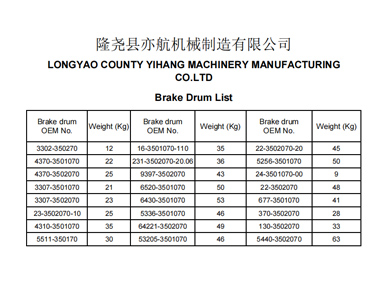Aug . 27, 2024 20:54 Back to list
Heavy Truck Brake Drums - Reliable Performance and Durability
Understanding Heavy Truck Brake Drums Importance, Design, and Maintenance
Heavy trucks play an indispensable role in freight transportation, and while many aspects of these vehicles are engineered for performance and safety, the brake system stands out as critical. Among the components of this system, brake drums are essential for ensuring the safety and effectiveness of heavy truck brakes.
Brake drums are cylindrical components attached to the wheel hubs of trucks fitted with drum brakes. When the brake pedal is pressed, the brake shoes expand against the inner surface of the drum, creating friction that slows down the vehicle. The design and material of the brake drums are paramount, as they need to endure extreme temperatures and pressures generated during braking. Typically, heavy truck brake drums are made of cast iron or a composite material that can withstand the rigors of heavy-duty performance.
One of the primary benefits of using brake drums in heavy trucks is their ability to effectively dissipate heat. When brakes are applied, heat is generated due to friction, which can lead to brake fade—an alarming reduction in braking efficiency. Well-designed brake drums are engineered to manage heat absorption and dissipation, thereby maintaining optimal braking performance even during extended use. This is crucial for heavy trucks, which often carry significant loads and require reliable stopping power.
heavy truck brake drums

In addition to their heat management abilities, heavy truck brake drums also contribute to the overall durability of the braking system. Since they encase the brake shoes and components, they protect these parts from dirt and road debris, helping to prolong their life. The robust construction of these drums helps minimize the likelihood of cracks and deformation, which can compromise braking efficiency and safety.
However, like all components of a heavy truck, brake drums require regular maintenance and inspection to ensure they operate effectively. One of the most common issues associated with brake drums is wear and tear due to continuous use. Drivers and fleet operators should routinely check the condition of the brake drums, looking for signs of warping, cracking, or excessive scoring on the drum's surface. Regular maintenance not only enhances safety but also helps in avoiding costly repairs or replacements in the future.
Another crucial aspect of maintaining brake drums is ensuring they are properly aligned and balanced. Misaligned or unbalanced brake drums can lead to uneven wear of brake shoes and other components, compromising the overall efficiency of the braking system. It is essential for heavy truck operators to work closely with skilled mechanics to perform regular checks and adjustments.
In conclusion, heavy truck brake drums are vital components that contribute to the overall safety and performance of the vehicle’s braking system. Their ability to withstand high temperatures, protect brake components, and maintain efficient stopping power makes them indispensable in heavy-duty applications. Regular maintenance and inspection are crucial to ensure these components remain functional and safe, ultimately supporting the reliable operation of heavy trucks in transporting goods across vast distances. As we continue to rely on heavy trucks for our transportation needs, understanding how to care for and maintain these critical components will help ensure safety on the roads.
-
HINO Industrial Solutions - ¡Ң���ຽ��е��������˾ | Advanced Efficiency&Customization
NewsJul.13,2025
-
HINO Industrial Efficiency Solutions - ¡Ң���ຽ��е��������˾
NewsJul.13,2025
-
HINO Industrial Solutions - ¡Ң���ຽ��е��������˾ | Advanced Technology&Reliability
NewsJul.13,2025
-
HINO Industrial Efficiency-Jiangsu Hino Industrial|Productivity Optimization&Cost Reduction
NewsJul.12,2025
-
HINO-¡Ң���ຽ��е��������˾|Advanced Industrial Solutions&Energy Efficiency
NewsJul.12,2025
-
Premium Brake Drum Iveco – Durable Drum Brake Drum & Brake Shoe Solutions
NewsJul.08,2025
